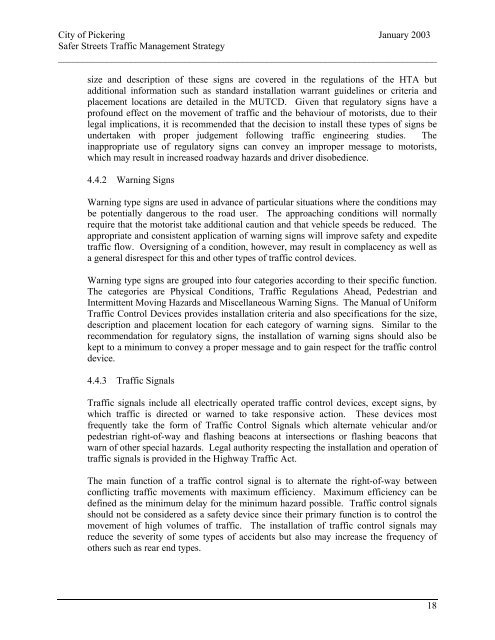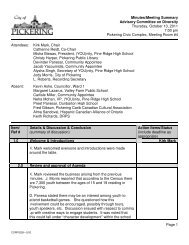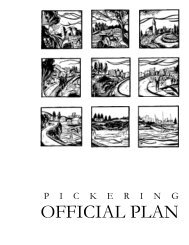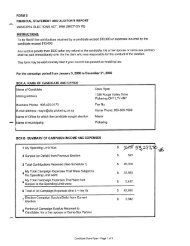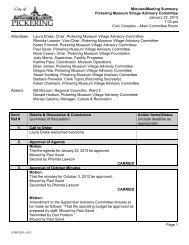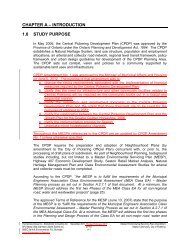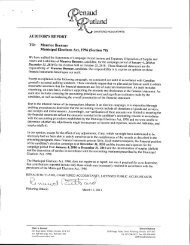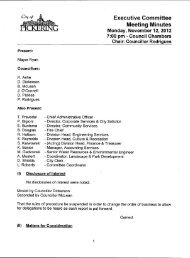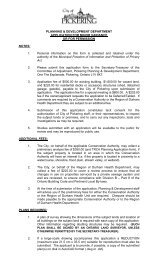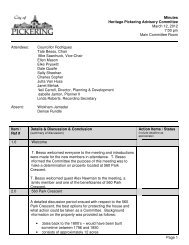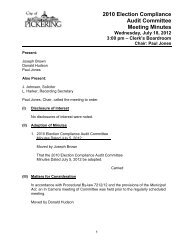foreword - City of Pickering
foreword - City of Pickering
foreword - City of Pickering
You also want an ePaper? Increase the reach of your titles
YUMPU automatically turns print PDFs into web optimized ePapers that Google loves.
<strong>City</strong> <strong>of</strong> <strong>Pickering</strong> January 2003<br />
Safer Streets Traffic Management Strategy<br />
______________________________________________________________________________<br />
size and description <strong>of</strong> these signs are covered in the regulations <strong>of</strong> the HTA but<br />
additional information such as standard installation warrant guidelines or criteria and<br />
placement locations are detailed in the MUTCD. Given that regulatory signs have a<br />
pr<strong>of</strong>ound effect on the movement <strong>of</strong> traffic and the behaviour <strong>of</strong> motorists, due to their<br />
legal implications, it is recommended that the decision to install these types <strong>of</strong> signs be<br />
undertaken with proper judgement following traffic engineering studies. The<br />
inappropriate use <strong>of</strong> regulatory signs can convey an improper message to motorists,<br />
which may result in increased roadway hazards and driver disobedience.<br />
4.4.2 Warning Signs<br />
Warning type signs are used in advance <strong>of</strong> particular situations where the conditions may<br />
be potentially dangerous to the road user. The approaching conditions will normally<br />
require that the motorist take additional caution and that vehicle speeds be reduced. The<br />
appropriate and consistent application <strong>of</strong> warning signs will improve safety and expedite<br />
traffic flow. Oversigning <strong>of</strong> a condition, however, may result in complacency as well as<br />
a general disrespect for this and other types <strong>of</strong> traffic control devices.<br />
Warning type signs are grouped into four categories according to their specific function.<br />
The categories are Physical Conditions, Traffic Regulations Ahead, Pedestrian and<br />
Intermittent Moving Hazards and Miscellaneous Warning Signs. The Manual <strong>of</strong> Uniform<br />
Traffic Control Devices provides installation criteria and also specifications for the size,<br />
description and placement location for each category <strong>of</strong> warning signs. Similar to the<br />
recommendation for regulatory signs, the installation <strong>of</strong> warning signs should also be<br />
kept to a minimum to convey a proper message and to gain respect for the traffic control<br />
device.<br />
4.4.3 Traffic Signals<br />
Traffic signals include all electrically operated traffic control devices, except signs, by<br />
which traffic is directed or warned to take responsive action. These devices most<br />
frequently take the form <strong>of</strong> Traffic Control Signals which alternate vehicular and/or<br />
pedestrian right-<strong>of</strong>-way and flashing beacons at intersections or flashing beacons that<br />
warn <strong>of</strong> other special hazards. Legal authority respecting the installation and operation <strong>of</strong><br />
traffic signals is provided in the Highway Traffic Act.<br />
The main function <strong>of</strong> a traffic control signal is to alternate the right-<strong>of</strong>-way between<br />
conflicting traffic movements with maximum efficiency. Maximum efficiency can be<br />
defined as the minimum delay for the minimum hazard possible. Traffic control signals<br />
should not be considered as a safety device since their primary function is to control the<br />
movement <strong>of</strong> high volumes <strong>of</strong> traffic. The installation <strong>of</strong> traffic control signals may<br />
reduce the severity <strong>of</strong> some types <strong>of</strong> accidents but also may increase the frequency <strong>of</strong><br />
others such as rear end types.<br />
18


